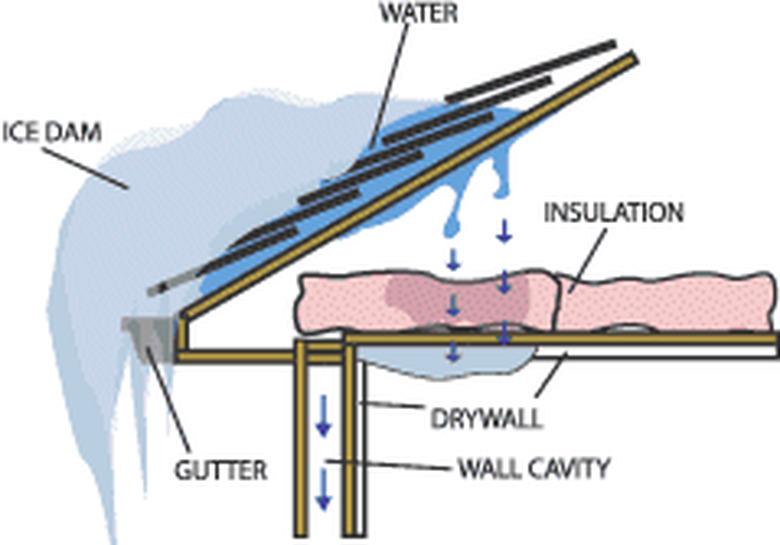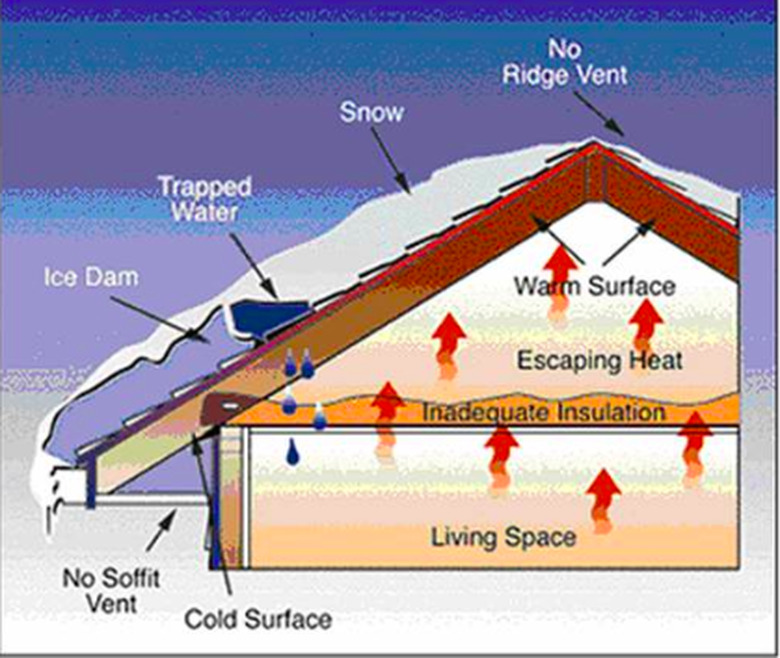Ice Dam Prevention And Removal
When you go outside to clear the sidewalk after a heavy snow, take a moment to look at the roof of your house. If you see icicles hanging from the eaves, there's a good chance that an ice dam has formed on the roof. If so, you better check for leaks in the attic. Ice dams are a major cause of roof leaks, and if ice dams occur year after year, they can cause your roof to deteriorate and sag, and eventually you'll have to replace it.
How Ice Dams Form
How Ice Dams Form
Paradoxically, the reason ice dams form when the roof is too warm—at least near the peak. When snow melts and slides down the roof, it freezes again when it reaches the colder sections of the roof down near the eaves. Gradually this can cause a backup of water that can eventually find its way under the roof shingles and into the attic. How can a roof get warm enough to melt snow in the winter? Usually, this happens before the attic floor is improperly insulated, allowing warmth to rise up into the attic space where it can melt snow on the outer roof. Properly constructed, an attic should also be well vented to the outdoors to circulate outdoor air and prevent the attic space from getting excessively warm.
One way to prevent ice dams, then, is to cool the roof by increasing attic insulation and ventilation. When that isn't possible, outfitting the roof near the eave edges with heat tape is another solution. This technique will melt ice dams before they can build up and back up into your attic space.
If you can't do either of these, you should have a roof rake in your tool shed so you can physically remove fresh snow from the roof before it starts to melt.
Anatomy of an Ice Dam
Anatomy of an Ice Dam
The outside temperature has to be 32 degrees F, or below for snow to fall, and the snow will accumulate on the roof only if the roof temperature is also below 32 F. However, once a blanket of snow covers the roof surface, the bottom layer of snow can start to heat up as warm air from inside the attic penetrates through the roof decking from inside. The bottom layer of snow touching the roof begins to melt, and eventually, the moisture begins to slide down the roof. However, because most of the warm air in an attic is located high up, near the peak, as water slides down the roof, it may refreeze again as it reaches the older section of the roof located near the eave overhang. This moisture freezes and turns to ice, and the water streaming down behind it begins to back up.
Two conditions are responsible for the variation in roof temperature, creating two possible strategies for addressing the problem. The first cause is that the attic floor and walls of the home don't have enough insulation. Warm air from the house can enter the attic directly through insufficient insulation, or may stream up into the attic through gaps in the thermal envelope, such as spaces around plumbing vent pipes, chimneys, or light fixture boxes mounted in the ceiling below.
The second cause is poor attic ventilation. If the attic ventilation is properly designed, warm air that does enter the attic is exhausted out through gable vents or roof vents and does not collect in the attic where it can heat up the roof decking.
Improving Insulation and Ventilation
Improving Insulation and Ventilation
The amount of attic insulation you need depends on the climactic zone in which you live, but according to EnergyStar.gov, you should insulate to a minimum of R-38 in most regions. The insulation goes in the bays between the ceiling joists, and as a rule of thumb, it should rise to the level of the tops of the ceiling joists or higher. Improving insulation in an attic is a simple matter of layering loose fill or unfaced fiberglass batts on top of existing loose fill or fiberglass insulation. Do not use faced batts as a secondary attic blanket, because the facing will lock moisture into the insulation underneath it, causing clumping and mold.
In a properly designed passive ventilation system, the total ventilation area of the soffit and roof or gable vents is equal to 1/150 the total floor area of the attic. The building code allows you to reduce this fraction to 1/300 if the ventilation is balanced, which means that the ventilation area provided by the soffit vents is equal to the area provided by the roof and gable vents.
If your attic doesn't have enough ventilation, consider adding more soffit and roof or gable vents. Do not simply install a ventilation fan. Active ventilation will only push the air around inside the attic—it won't help the warm air escape, and it won't solve your ice dam problem.
Heat Tape and Roof Rakes
There are instances where adding attic insulation or improving ventilation isn't practical, as well as climates that are so cold that ice dams may form despite best preventive efforts. For these situations, there is heat tape.
Heat tape is electrically powered cording that is applied in an S-pattern or an up-and-down zigzag over the roof surface where ice dams usually form. It is attached to the shingles with special clips. If you happen to be having your roof replaced, you can also install heat tape underneath shingles and other roof coverings. By heating the lower areas of the roof, heat tapes prevents the moisture from refreezing when it reaches the lower sections of the roof, allowing it to instead simply drip off onto the ground.
Heat tape typically plugs into a GFCI outlet on the outside of the house, and you can save energy by unplugging it when you don't need it. You can also plug it into a timer so that it comes on during at specific times each day—usually between 6 a.m. and 6 p.m. when snow at the peak is most likely to be melting.
A roof rake is a simple tool that allows you to clear snow in emergency situations, such as periods of heavy accumulation or when you can't implement other remedies. If your house is prone to ice dams, it's a good idea to have one in your garage even if your roof has heat tape because, like all electrical appliances, heat tape is prone to shorts and other problems. When raking your roof, you only need to worry about the sections about two or three feet higher than the eaves, because this is where snow melt typically refreezes. The telescoping handle allows you to reach the roof on most houses except for the very highest ones.
Take care when a roof rake not to scrape the shingles too vigorously. It's better to leave a light coating of snow on the shingles themselves rather than scrape the shingles with the metal blade of the shovel.




